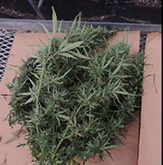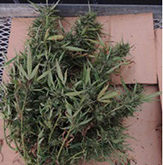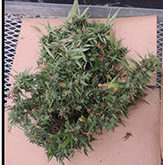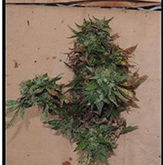Interest in hemp cultivation for various markets has increased since the 2014 and 2018 US Farm Bills legalized its production. In 2019, there were 114 licensed hemp growers in SC.1 The number of licensed hemp growers will likely increase because hemp is becoming an economically significant agricultural crop in SC.1 Domestic production of hemp has been a slow process in comparison to the supply chain demand in the US. Thus the majority of hemp for food and fiber products has come from Canada and China.2 Cannabidiol (CBD) production is currently the most popular market for hemp in the US. Region-specific recommendations for growing hemp (e.g., specific varieties, irrigation frequency, standard fertility, and weed management) are lacking.3 This article discusses why and how to select hemp varieties and the importance of keeping hemp plants weed-free in coastal SC production systems.
Selecting a Variety
When selecting a hemp variety for your operation, consider these factors:
- ability to effectively grow in the regional environment (weather, and tolerance to insects and disease),
- bud yield potential,
- competitiveness with weeds
- CBD concentrations in bud extract
Bud Yield Potential
The bud yield potential and percentage of CBD in hemp may be influenced by weather, hemp variety, irrigation, fertility, disease, insects, and weed completion. This article strictly focuses on the impact of weed competition and variety selection on bud yield in weight and not CBD content. Future Land-Grant Press articles will focus on the impact of cultural practices and varietal selections on CBD production.
Accounting for the Coastal South Carolina Environment
Hemp varieties selected for production in coastal SC need to tolerate heat and humidity. Currently, almost all varieties are from places that do not have the same climate as SC, such as Colorado, Oregon, and Washington. Progress has been made by local breeders utilizing those germplasm lines, selecting individuals that hold under southern climate and pest pressures, maintain yield and CBD content, and low total Tetrahydrocannabinol (THC) content. Normal breeding can take up to two years to release a line. What works in Washington may not automatically work here; furthermore, most of these lines are also day-length sensitive, meaning that bud production could be different here than in the northwest due to phototropic effects. In a coastal SC study, Boax, Cherry Blossom, and Cherry Wine varieties generally yielded higher bud weights than Hurricane, T1, and Therapy. Based on bud yield weights alone, Boax, Cherry Blossom, and Cherry Wine (figure 1a-c) perform well along the coastal region of SC. Boax was the preferred variety based on having the highest average bud weight across all weed free intervals. Therapy (figure 1d) did not grow well in coastal SC. Hurricane appeared to be pretty competitive, with only a 1-week, weed-free interval. This cultivar was bred to have a quickly established root system early on while having somewhat latent foliage growth, which makes it more tolerant to wind storms during establishment. The inconsistency yield of Hurricane warrants further testing in coastal SC before a recommendation can be made regarding the use of this cultivar in this region.
Figure 1. Boax (1a, top left), Cherry Wine (1b, top right), Cherry Blossom (1c, bottom left), and Therapy (1d, bottom right) varieties harvested from the 2-week, weed-free interval treatment. Note that Therapy bud mass collected is much smaller by looking at grid size in the background.
Competitiveness With Weeds
The high temperatures and rainfall characteristics of coastal SC facilitate prolific weed growth. Weeds can outcompete slow-growing hemp varieties for sunlight, as well as water and nutrients below ground. Furthermore, some weeds can produce chemicals (natural herbicides) that stunt neighboring crop growth. In other parts of the US, hemp growth and bud production are reduced by weed competition.3 In particular, keeping the field weed-free for a certain amount of time while plants are establishing is important for bud yield. For coastal SC, the field should remain weed-free for, at a minimum, the first week after transplant to maximize bud yields (figure 2). For most cultivars, growers should aim to keep hemp fields weed-free for two to four weeks to ensure acceptable bud production.
Failure to control weeds in hemp production fields in the coastal SC environment will drastically reduce hemp bud yields. Based on this single year study alone, weed control extending past four weeks in a hemp production setting in coastal SC may not significantly increase bud yields. The size of the plants and the extent of their root system likely limited the effect that fledgling weed competition had on hemp growth at the 4-week post-transplant period. However, extending control beyond four weeks can reduce the number of viable weed seeds returned to the soil and reduce weed pressure for future plantings. There are potential new herbicides on the horizon that may become registered for weed control in conventional hemp, which will assist growers with maintaining the 4-week, weed-free period.4 Future Land-Grant Press articles will address herbicide safety in hemp production. Until herbicides become registered in hemp, mechanical cultivation, flame weeding, or plasticulture combined with hand weeding are the best methods to control weeds in hemp production.
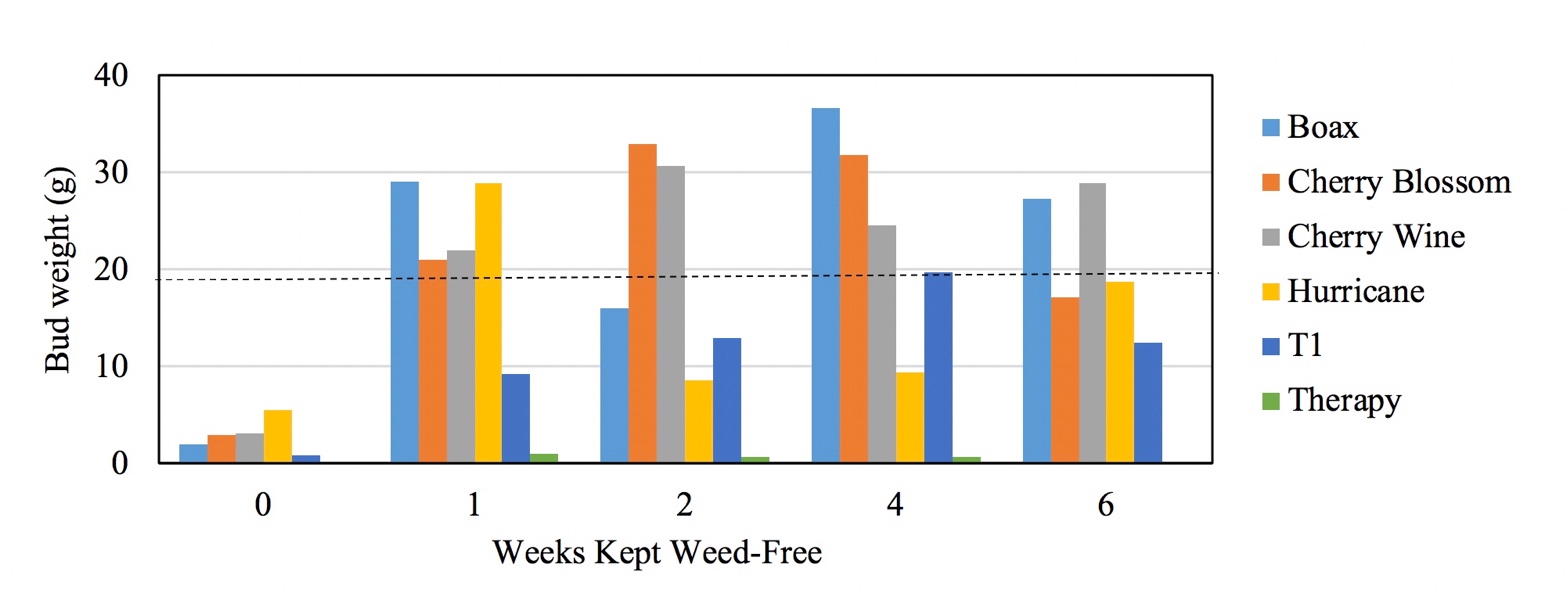
Figure 2. The average bud weight in grams (g) for each variety at harvest when the fields were weed-free for different intervals after transplant. The dotted line is based on acceptable yields from other hemp production trials conducted in coastal SC. Image credit: Harrison T. Campbell, Clemson University.
References Cited
- 114 SC Hemp Farmers Approved for 2019 Growing Season. Press Release. South Carolina Department of Agriculture. 2019 [accessed 2020 Jan 15]. https://agriculture.sc.gov/114-sc-hemp-farmers-approved-for-2019-growing-season/.
- Smart LB. Evaluation of hemp cultivars in New York State on the path to establishing a comprehensive hemp breeding program. 2019 ASA-CSSA-SSSA International Annual Meeting, Nov 10–13, San Antonio, Texas. p. 126.
- Post A, Overbaugh E, Grandon B, Edmisten K, Heiniger R. The effect of nitrogen rate on industrial hemp cann+abidiol production. 2019 ASA-CSSA-SSSA International Annual Meeting, Nov 10–13, San Antonio, Texas. p. 147.
- Flessner ML, Byrd J, Bamber KW, Fike JH. Evaluating herbicide tolerance of industrial hemp (Cannabis Sativa L.) Crop Science. 2020;60:419–427. doi.org/10.1002/csc2.20055.

